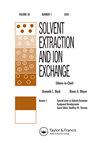Solvent Phase Optimizations Improve Correlations with Experimental Stability Constants for Aqueous Lanthanide Complexes
IF 2.1
4区 化学
Q3 CHEMISTRY, MULTIDISCIPLINARY
引用次数: 1
Abstract
ABSTRACT Stability constants provide insight into ion complexation in water. While computational studies have been shown to model the energy of the complexation successfully using a thermodynamic cycle approach, it does not extend to calculating the stability constants for 1:1 lanthanide to ligand complexes in solution. Using B3LYP and 6-31+G* Pople basis with small core effective core potential (ECP) on the lanthanum ion, and a solvent model based on the full solute electron density (SMD) solvation model we computed and compared with previously published stability constants of the ligands: acetate, acetohydroximate, acetylacetonate, methanoate, tropolonate, hydroxide, catecholate, malonate, oxalate, phthalate, and sulfate. The best R2 values for the thermodynamic cycle can only be determined by separating the mono and divalent ions to achieve an R2 value of 0.86 and 0.74 for mono and divalent ions, respectively. We show that by optimizing the lanthanide-ligand structures in implicit solvent, we achieve an improved correlation between experimental and computed stability constants of R2 value of 0.89 for the combined mono and divalent ions.溶剂相优化改善了镧系水配合物与实验稳定常数的相关性
摘要稳定性常数提供了对水中离子络合作用的深入了解。虽然计算研究表明,使用热力学循环方法可以成功地模拟络合的能量,但它并没有扩展到计算溶液中1:1镧系元素与配体络合物的稳定常数。使用B3LYP和6-31+G*Pople基,在镧离子上具有小核有效核电位(ECP),以及基于全溶质电子密度(SMD)溶剂化模型的溶剂模型,我们计算了配体的稳定性常数,并与先前发表的配体的稳定性常数进行了比较:乙酸盐、乙酰氢肟酸盐、乙酰丙酮酸盐、甲烷酸盐、原克隆酸盐、氢氧化物、邻苯二酚酸盐、丙二酸盐、草酸盐、邻苯二甲酸盐,和硫酸盐。热力学循环的最佳R2值只能通过分离一价和二价离子来确定,以使一价和两价离子的R2值分别为0.86和0.74。我们表明,通过优化隐式溶剂中的镧系元素配体结构,我们改善了实验和计算的稳定常数之间的相关性,对于组合的一价和二价离子,R2值为0.89。
本文章由计算机程序翻译,如有差异,请以英文原文为准。
求助全文
约1分钟内获得全文
求助全文
来源期刊
CiteScore
4.40
自引率
5.00%
发文量
15
审稿时长
8.4 months
期刊介绍:
Solvent Extraction and Ion Exchange is an international journal that publishes original research papers, reviews, and notes that address all aspects of solvent extraction, ion exchange, and closely related methods involving, for example, liquid membranes, extraction chromatography, supercritical fluids, ionic liquids, microfluidics, and adsorption. We welcome submissions that look at: The underlying principles in solvent extraction and ion exchange; Solvent extraction and ion exchange process development; New materials or reagents, their syntheses and properties; Computational methods of molecular design and simulation; Advances in equipment, fluid dynamics, and engineering; Interfacial phenomena, kinetics, and coalescence; Spectroscopic and diffraction analysis of structure and dynamics; Host-guest chemistry, ion receptors, and molecular recognition.

 求助内容:
求助内容: 应助结果提醒方式:
应助结果提醒方式:


